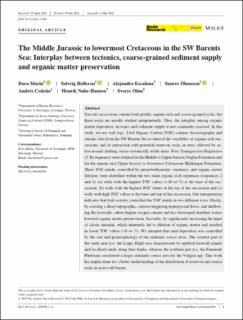| dc.contributor.author | Marin Restrepo, Dora Luz | |
| dc.contributor.author | Helleren, Solveig | |
| dc.contributor.author | Escalona Varela, Alejandro | |
| dc.contributor.author | Olaussen, Snorre | |
| dc.contributor.author | Cedeno Motta, Andres Felipe | |
| dc.contributor.author | Nøhr-Hansen, Henrik | |
| dc.contributor.author | Ohm, Sverre Ekrene | |
| dc.date.accessioned | 2023-01-12T08:54:31Z | |
| dc.date.available | 2023-01-12T08:54:31Z | |
| dc.date.created | 2020-09-11T17:42:55Z | |
| dc.date.issued | 2020 | |
| dc.identifier.citation | Marín, D., Helleren, S., Escalona, A., Olaussen, S., Cedeño, A., Nøhr‐Hansen, H., & Ohm, S. (2021). The Middle Jurassic to lowermost Cretaceous in the SW Barents Sea: Interplay between tectonics, coarse‐grained sediment supply and organic matter preservation. Basin Research, 33(2), 1033-1055. | en_US |
| dc.identifier.issn | 0950-091X | |
| dc.identifier.uri | https://hdl.handle.net/11250/3042885 | |
| dc.description.abstract | Syn‐rift successions contain both prolific organic‐rich and coarse‐grained rocks, but these rocks are usually studied independently. Thus, the interplay among organic matter deposition, tectonics and sediment supply is not commonly assessed. In this study, we use well logs, Total Organic Carbon (TOC) content, biostratigraphy and seismic data from the SW Barents Sea to unravel the variability of organic‐rich successions and its interaction with potential reservoir rocks in areas affected by active normal faulting versus tectonically stable areas. Four Transgressive‐Regressive (T‐R) sequences were defined for the Middle to Upper Jurassic Fuglen Formation and for the organic‐rich Upper Jurassic to lowermost Cretaceous Hekkingen Formation. Three TOC trends, controlled by palaeobathymetric variations, and organic matter dilution, were identified within the two main organic‐rich sequences (sequences 2 and 3): (a) wells with the highest TOC values (>10 wt %) at the base of the succession; (b) wells with the highest TOC values at the top of the succession and (c) wells with high TOC values at the base and top of the succession. Our interpretation indicates that fault activity controlled the TOC trends in two different ways: Firstly, by creating a sharp topographic contrast‐triggering hyperpycnal flows, and shallowing the footwalls, where higher oxygen content and less developed stratified waters lowered organic matter preservation. Secondly, by significantly increasing the input of clastic material, which inherently led to dilution of organic matter and resulted in lower TOC values (<6 wt %). We interpret that sand deposition was controlled by the size and geomorphology of the sediment source areas. The western part of the study area (i.e. the Loppa High) was characterized by uplifted footwall islands and localized sands along their flanks, whereas the southern part (i.e. the Finnmark Platform) constituted a larger sediment source area for the Volgian age. This work has implications for a better understanding of the distribution of reservoir and source rocks in active rift basins. | en_US |
| dc.language.iso | eng | en_US |
| dc.publisher | EAGE | en_US |
| dc.rights | Navngivelse 4.0 Internasjonal | * |
| dc.rights.uri | http://creativecommons.org/licenses/by/4.0/deed.no | * |
| dc.title | The Middle Jurassic to lowermost Cretaceous in the SW Barents Sea: Interplay between tectonics, coarse-grained sediment supply and organic matter preservation | en_US |
| dc.type | Peer reviewed | en_US |
| dc.type | Journal article | en_US |
| dc.description.version | publishedVersion | en_US |
| dc.rights.holder | the authors | en_US |
| dc.subject.nsi | VDP::Matematikk og Naturvitenskap: 400::Geofag: 450 | en_US |
| dc.source.pagenumber | 1033-1055 | en_US |
| dc.source.volume | 33 | en_US |
| dc.source.journal | Basin Research | en_US |
| dc.source.issue | 2 | en_US |
| dc.identifier.doi | 10.1111/bre.12504 | |
| dc.identifier.cristin | 1829251 | |
| cristin.ispublished | true | |
| cristin.fulltext | original | |
| cristin.qualitycode | 2 | |

